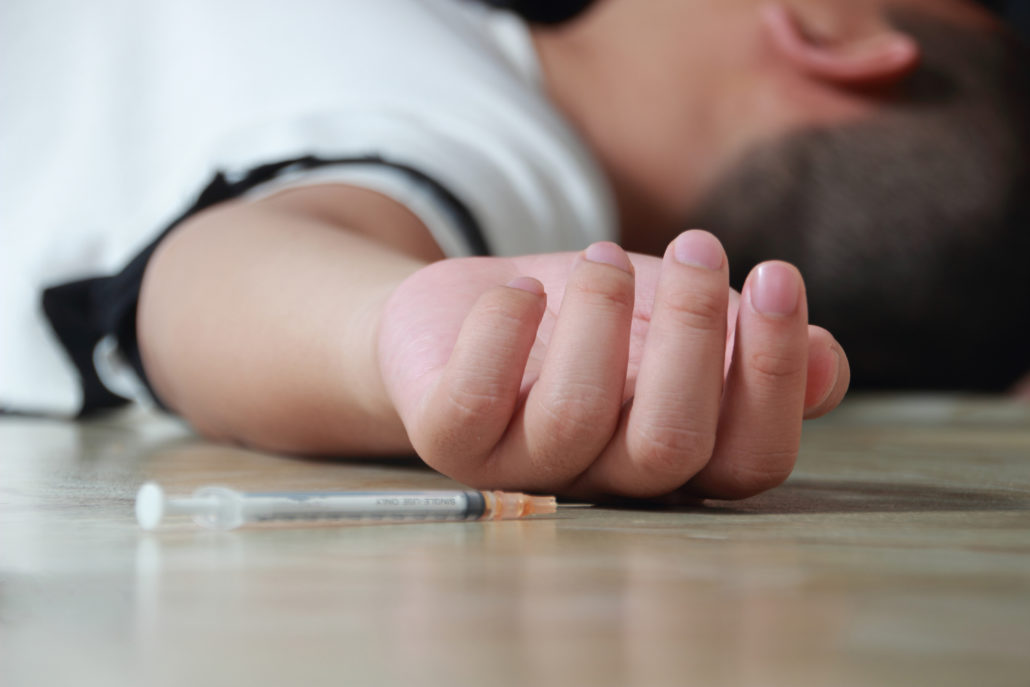What are Intravenous Drugs?
Intravenous drug use involves injecting chemicals into the body through a hypodermic needle (syringe) into a vein. The practice of “shooting up,” or injecting drugs directly into the bloodstream using a needle is dangerous, as it can create intense effects that can speed the progress of addiction, as well as the likelihood of experiencing an overdose.
Drugs can also be injected under the skin, also called skin popping, or directly into the muscle (intramuscular injection). Injecting a drug allows it to enter the bloodstream immediately, which increases the speed of delivery to the brain. The effects can often be felt within a minute of injecting the drug.
Nearly all drugs can be injected by dissolving pills, powders, or salts into a liquid solution and using a hypodermic needle to get the liquid into a vein. Heroin is an illegal drug that is most commonly administered by intravenous injection. Still, other drugs such as methamphetamines, amphetamines, opioid pain killers, and cocaine can be administered by intravenous (IV) injection.
HIV And Intravenous Drug Use
- According to the World Health Organization (WHO) [1], around 11 million people inject drugs globally. Approximately 1 in 8 (or 1.4 million) of these people are living with HIV, while 39.4% have viremic HCV infection. Thus, injecting drug use accounts for approximately 10% of new HIV infections globally.
- According to the Center for Disease Control and Prevention (CDC) [2], sharing needles, syringes, or other equipment to inject drugs places people at high risk for getting or transmitting HIV and other infections. People who inject drugs account for about 1 in 10 HIV diagnoses in the United States.
- An HIV-negative person has a 1 in 160 chance of getting HIV every time they use a needle that someone with HIV has used. This is because the needles, syringes, or other injection equipment may have blood in them, and blood can carry HIV. HIV can survive in a used syringe for up to 42 days, depending on temperature and other factors. This according to CDC [3].

- Sharing syringes is the second-riskiest behavior for getting HIV. Receptive anal sex is the riskiest. Substance use disorder can also increase the risk of getting HIV through sex. When people are under the influence of substances, they are more likely to engage in risky sexual behaviors, such as having anal or vaginal sex without protection.
- LGBTQ people are also at increased risks for HIV due to both intravenous drug use and risky sexual behaviors. HIV infection is particularly prevalent among gay and bisexual men (men who have sex with men, or MSM) and transgender women who have sex with men. SUD treatment can also help prevent HIV transmission among those at high risk. For example, addiction treatment is associated with reduced drug use and less risky sexual behavior among MSM, and those with HIV report improvements in viral load. This is according to the National Institute of Health (NIH) [4].
Intravenous Drug Use Overdose
Overdose leading to death is a major adverse health effect of intravenous drug abuse. The National Institute on Drug Abuse (NIDA) [5] in 2019, nearly 50,000 people in the United States died from opioid-involved overdoses, much-involving fentanyl. Fentanyl is a synthetic opioid that is a hundred times more powerful than morphine and is used to treat severer pain. WHO [6] says that intravenous drug users have a higher risk of death than non-injection users due to overdose and HIV/AIDS-related mortality. When many pills are crushed and injected, they are often laced with other drugs or additives, resulting in toxic interactions in the body that may lead to overdose. These overdoses can cause difficult-to-treat complications or even death.
Signs Of Intravenous Drug Use Overdose
- Differential pupil size or behavior
- Breathing problems.
- Diarrhea
- Temperature changes in the body
- Uncertainty
- Perplexity
- Effervescence
- Depression
- A feeling of unease
- Vomiting or nausea
- Convulsions or tremors
- Heart rate fluctuation
- Increase in blood pressure
- Drowsiness
- Visual and auditory hallucinations
- Sweating
- Unconsciousness
- Hostility or abuse
- Death
Side Effects Of Intravenous Drug Use
Infection
Infection may happen at the injection site. To help prevent infection, injection must be done carefully using sterile (germ-free) equipment. An infection from the injection site can also travel into your bloodstream. This can cause a severe infection throughout your body. People who inject drugs are at risk of serious infections, such as necrotizing fasciitis, wound botulism, and cutaneous anthrax due to the nature of the substances they inject.
Damage To Veins And Injection Site
A vein can be damaged during the injection. This can cause infiltration. When this happens, medication leaks into the surrounding tissue instead of going into your bloodstream. Infiltration can cause tissue damage. Syringe injection can also cause phlebitis or inflammation of the veins. Symptoms of both infiltration and phlebitis include swelling and pain at the injection site.
Leg Ulceration
Injecting in the femoral vein is becoming increasingly common among people who have been injecting drugs for a long time, as well as those who are new to injecting. This may be because the femoral vein is large and can tolerate repeated puncture. In addition, the injection site is hidden from view. This is a known risk factor for the development of leg ulceration. Feet may become discolored and purple, ankle flare, and skin staining.
Endocarditis
It is a condition defined by inflammation of the interior lining of the heart. It can happen from repeated intravenous drug use. A lot of drug users inject drugs into veins that drain into the right side of the heart. As a result, the right-sided heart valves can develop endocarditis. In addition, bacteria from unsanitized syringes can also lead to this condition. If left untreated, endocarditis can damage or destroy heart valves and can lead to life-threatening complications.
Air Embolism
If air gets into the syringe and the line runs dry, air bubbles can enter your vein. These air bubbles can then travel to your heart or lungs and block your blood flow. An air embolism can cause severe health concerns, such as heart attack or stroke.
Blood Clots
IV therapy can cause blood clots to form. Clots can block important veins and cause health concerns such as tissue damage or even death. Deep vein thrombosis is one type of dangerous blood clot that IV treatment can cause. Symptoms include pain and swelling in one leg, chest pain, or numbness on one side of the body.
Intravenous Drug Addiction Treatment
Addiction recovery is more than stopping drinking or using. It is an ongoing process of growing and healing-mentally, emotionally, physically, and spiritually. Recovery is a process, but one that begins with detoxing the body from the presence of any drugs and continues indefinitely.
Following a detox program, other levels of care provide continued physical and emotional support to those in recovery. Recovery programs also help clients develop tools and coping mechanisms for intravenous drug relapse prevention.
Intravenous Drug Detox
The detoxification and stabilization phase of treatment is designed for people who experience withdrawal symptoms following prolonged abuse of drugs. Detox is a process of medical care and pharmacotherapy that seeks to help the person achieve abstinence with the minimum of physical and emotional discomfort. The detox process will look different for everyone because how long the substance stays in the system can vary. For some, it may require medical assistance due to the severity of the withdrawal symptoms.
Through the admissions process, our team at We Level Up Florida is working to determine the severity of a client’s addiction and dependence, as well as any unique factors that may influence their recovery process. With this information, they will ensure admission to the most beneficial treatment facility, help with travel arrangements, and develop a personalized treatment plan.
Benefits of An Inpatient Detox Program:
- 24/7 medical observation
- Luxury facilities & amenities
- Medication assistance for withdrawal symptoms
- Nutritional supplements provided to support detox
- Access to alternative detox therapies
Behavioral Therapies
Cognitive Behavioral Therapy (CBT) and Dialectical Behavioral Therapy (DBT) can improve individuals’ behavior. CBT targets negative and maladaptive thought patterns as it promotes positive emotions and beliefs, while DBT helps individuals address conflicting impulses so they can make healthy choices. Both therapies treat substance abuse, anxiety disorders, and other mood issues. Therapy also empowers the person to identify, avoid and mitigate cues that trigger drug cravings. As with all addictions, health care providers should screen for co-occurring mental health conditions. There are medicines available for common co-occurring conditions.
Individual and Group Counseling
Addiction and mental health counseling occur in both individual and group settings. One-on-one treatment sessions may address unresolved trauma, unconscious conflicts, and specific struggles, while group sessions often involve training in life skills, stress management, conflict resolution, and social connections. Group counseling also gives individuals the chance to share their thoughts and experiences to develop social support, which is important for lasting recovery.

Find the Right Primary Mental Health Treatment with Secondary Co-Occurring Addiction Diagnosis
Inpatient medical detox and residential primary addiction treatment may be available at our affiliated facility at Level Up West Palm Beach Rehab. For some primary behavioral health treatment clients, medical detox and or addiction rehab may be required first. If you have a co-occurring severe substance abuse diagnosis, please contact us prior to beginning inpatient mental health therapy. Treatment services may vary. Please call us to learn which treatment options are most suited for your individual needs.
Sources
[1][6] WHO – https://www.who.int/teams/global-hiv-hepatitis-and-stis-programmes/populations/people-who-inject-drugs
[2][3] CDC – https://www.cdc.gov/hiv/risk/drugs/index.html
[4] NIH – https://www.drugabuse.gov/drug-topics/substance-use-suds-in-lgbtq-populations
[5] NIDA – [4] NIDA – https://www.drugabuse.gov/drug-topics/opioids/opioid-overdose-crisis